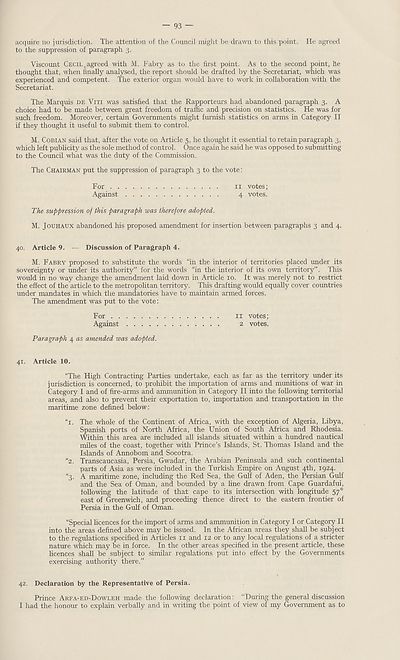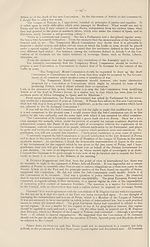Armament > Conference for the control of the international trade in arms, munitions and implements of war
(95)
Download files
Complete book:
Individual page:
Thumbnail gallery: Grid view | List view

93 —
acquire no jurisdiction. The attention of the Council might be drawn to this point. He agreed
to the suppression of paragraph 3.
Viscount Cecil .agreed with M. Fabry as to the first point. As to the second point, he
thought that, when finally analysed, the report should be drafted by the Secretariat, which was
experienced and competent. The exterior organ would have to work in collaboration with the
Secretariat.
The Marquis de Viti was satisfied that the Rapporteurs had abandoned paragraph 3. A
choice had to be made between great freedom of traffic and precision on statistics. He was for
such freedom. Moreover, certain Governments might furnish statistics on arms in Category II
if they thought it useful to submit them to control.
M. Cobian said that, after the vote on Article 5, he thought it essential to retain paragraph 3,
which left publicity as the sole method of control. Once again he said he was opposed to submitting
to the Council what was the duty of the Commission.
The Chairman put the suppression of paragraph 3 to the vote:
For 11 votes;
Against 4 votes.
The suppression of this paragraph was therefore adopted.
M. Jouhaux abandoned his proposed amendment for insertion between paragraphs 3 and 4.
40. Article 9. — Discussion of Paragraph 4.
M. Fabry proposed to substitute the words “in the interior of territories placed under its
sovereignty or under its authority” for the words “in the interior of its own territory”. This
would in no way change the amendment laid down in Article 10. It was merely not to restrict
the effect of the article to the metropolitan territory. This drafting would equally cover countries
under mandates in which the mandatories have to maintain armed forces.
The amendment was put to the vote:
For 11 votes;
Against 2 votes.
Paragraph 4 as amended was adopted.
41. Article 10.
“The High Contracting Parties undertake, each as far as the territory under its
jurisdiction is concerned, to prohibit the importation of arms and munitions of war in
Category I and of fire-arms and ammunition in Category II into the following territorial
areas, and also to prevent their exportation to, importation and transportation in the
maritime zone defined below:
“1. The whole of the Continent of Africa, with the exception of Algeria, Libya,
Spanish ports of North Africa, the Union of South Africa and Rhodesia.
Within this area are included all islands situated within a hundred nautical
miles of the coast, together with Prince’s Islands, St. Thomas Island and the
Islands of Annobom and Socotra.
“2. Transcaucasia, Persia, Gwadar, the Arabian Peninsula and such continental
parts of Asia as were included in the Turkish Empire on August 4th, 1924.
“3. A maritime zone, including the Red Sea, the Gulf of Aden, the Persian Gulf
and the Sea of Oman, and bounded by a line drawn from Cape Guardafui,
following the latitude of that cape to its intersection with longitude 570
east of Greenwich, and proceeding thence direct to the eastern frontier of
Persia in the Gulf of Oman.
“Special licences for the import of arms and ammunition in Category I or Category II
into the areas defined above may be issued. In the African areas they shall be subject
to the regulations specified in Articles 11 and 12 or to any local regulations of a stricter
nature which may be in force. In the other areas specified in the present article, these
licences shall be subject to similar regulations put info effect by the Governments
exercising authority there.”
42. Declaration by the Representative of Persia.
Prince Arfa-ed-Dowleh made the following declaration: “During the general discussion
I had the honour to explain verbally and in writing the point of view of my Government as to
acquire no jurisdiction. The attention of the Council might be drawn to this point. He agreed
to the suppression of paragraph 3.
Viscount Cecil .agreed with M. Fabry as to the first point. As to the second point, he
thought that, when finally analysed, the report should be drafted by the Secretariat, which was
experienced and competent. The exterior organ would have to work in collaboration with the
Secretariat.
The Marquis de Viti was satisfied that the Rapporteurs had abandoned paragraph 3. A
choice had to be made between great freedom of traffic and precision on statistics. He was for
such freedom. Moreover, certain Governments might furnish statistics on arms in Category II
if they thought it useful to submit them to control.
M. Cobian said that, after the vote on Article 5, he thought it essential to retain paragraph 3,
which left publicity as the sole method of control. Once again he said he was opposed to submitting
to the Council what was the duty of the Commission.
The Chairman put the suppression of paragraph 3 to the vote:
For 11 votes;
Against 4 votes.
The suppression of this paragraph was therefore adopted.
M. Jouhaux abandoned his proposed amendment for insertion between paragraphs 3 and 4.
40. Article 9. — Discussion of Paragraph 4.
M. Fabry proposed to substitute the words “in the interior of territories placed under its
sovereignty or under its authority” for the words “in the interior of its own territory”. This
would in no way change the amendment laid down in Article 10. It was merely not to restrict
the effect of the article to the metropolitan territory. This drafting would equally cover countries
under mandates in which the mandatories have to maintain armed forces.
The amendment was put to the vote:
For 11 votes;
Against 2 votes.
Paragraph 4 as amended was adopted.
41. Article 10.
“The High Contracting Parties undertake, each as far as the territory under its
jurisdiction is concerned, to prohibit the importation of arms and munitions of war in
Category I and of fire-arms and ammunition in Category II into the following territorial
areas, and also to prevent their exportation to, importation and transportation in the
maritime zone defined below:
“1. The whole of the Continent of Africa, with the exception of Algeria, Libya,
Spanish ports of North Africa, the Union of South Africa and Rhodesia.
Within this area are included all islands situated within a hundred nautical
miles of the coast, together with Prince’s Islands, St. Thomas Island and the
Islands of Annobom and Socotra.
“2. Transcaucasia, Persia, Gwadar, the Arabian Peninsula and such continental
parts of Asia as were included in the Turkish Empire on August 4th, 1924.
“3. A maritime zone, including the Red Sea, the Gulf of Aden, the Persian Gulf
and the Sea of Oman, and bounded by a line drawn from Cape Guardafui,
following the latitude of that cape to its intersection with longitude 570
east of Greenwich, and proceeding thence direct to the eastern frontier of
Persia in the Gulf of Oman.
“Special licences for the import of arms and ammunition in Category I or Category II
into the areas defined above may be issued. In the African areas they shall be subject
to the regulations specified in Articles 11 and 12 or to any local regulations of a stricter
nature which may be in force. In the other areas specified in the present article, these
licences shall be subject to similar regulations put info effect by the Governments
exercising authority there.”
42. Declaration by the Representative of Persia.
Prince Arfa-ed-Dowleh made the following declaration: “During the general discussion
I had the honour to explain verbally and in writing the point of view of my Government as to
Set display mode to:
![]() Universal Viewer |
Universal Viewer | ![]() Mirador |
Large image | Transcription
Mirador |
Large image | Transcription
Images and transcriptions on this page, including medium image downloads, may be used under the Creative Commons Attribution 4.0 International Licence unless otherwise stated. ![]()
| League of Nations > Armament > Conference for the control of the international trade in arms, munitions and implements of war > (95) |
|---|
| Permanent URL | https://digital.nls.uk/195382998 |
|---|
| Shelfmark | LN.IX |
|---|
| Description | Over 1,200 documents from the non-political organs of the League of Nations that dealt with health, disarmament, economic and financial matters for the duration of the League (1919-1945). Also online are statistical bulletins, essential facts, and an overview of the League by the first Secretary General, Sir Eric Drummond. These items are part of the Official Publications collection at the National Library of Scotland. |
|---|---|
| Additional NLS resources: |
|

